Data Science Services for Football Clubs
We use data to help clubs make evidence informed decisions
Football clubs make decisions on multi million pound deals, whether they be new signings, contract extensions, or managerial changes.
To do this well they need to gather the best available evidence and analyse it.
As a football club you will receive proposals all the time offering you unique data. We do not offer data, we help you to interpret the data you already have so you can make rational and pragmatic decisions.
We hope that after reading this document you will see what we are able to do with the information we have available to us, and appreciate what we would be able to do with access to the performance and recruitment data you already pay for.
We don’t lock customers into long contracts, we work on a per project or per season basis with affordable fees.
Data in Football
Who we are: We are a team of data scientists and consultants with a passion for football. By combining our interests we are able to help football clubs to make the most out of the data they hold. We don’t believe in data for the sake of data, we understand the complexity of football. Our services are affordable for clubs starting out in data analytics and can be ordered on a per project or per season basis.
What we do: Football clubs have access to large volumes of data.
Providers such as Opta, Statsbomb and Wyscout record almost every action in a significant number of leagues around the world. We know what to do with event data files such as the Opta F24 data and how to turn it into easy to use information for coaches.
It has never been simpler to find the players in good form, who are excelling in a specific role within their team.
The downside of this simplicity is that everybody has access to the same data. The simple reports produced and provided by the suppliers are simple to use. But they only scratch the surface of what can be done.
Clubs will only gain advantages over the other users of the recruitment systems they use if they find unique insights. This means using data science.
Data science is the use of technology to solve analytical problems.
The problem most clubs have is finding staff able to understand both the technical data and who understand football enough to produce meaningful information for the recruitment department and coaching team.
Clubs need data scientists who can explain, in plain English, what data you hold and what can be done with it. Your coaching staff or recruitment team may already be full of ideas about what insights data could bring, or they may need to be introduced to the possibilities.
There are also cost considerations. Establishing an entire department to undertake data analysis requires a large investment with uncertain benefits. If you create a specific role as a data analyst you are putting a lot of faith in a single individual to have all the skills required to get the most out of your systems.
We can provide those skills at a price you can afford.
Our portfolio of work:
To demonstrate the insights you can gain through data science we have put together a portfolio of work we have done, just using the data available to us. With the more detailed information available to clubs this work could be significantly expanded.
We have produced a case study of a recruitment project at Swansea City to demonstrate both our understanding of football needs and our ability to use data and traditional scouting methods to make realistic, affordable recruitment recommendations.
We can take the data available only to professional football clubs, such as event data files supplied by Opta, Statsbomb, and Wyscout and turn it into unique visuals to improve your ability on the pitch.
Further links are provided at the end of this document to articles and analysis we have published elsewhere which will give a full view of our capabilities.
This includes a unique pass scoring model based on XY coordinates and pass type.


Technical scouting and analysis
Swansea City squad analysis and recruitment process
Data-informed scouting
The recent success of Liverpool and Norwich, and their reliance on data-informed scouting, has highlighted that consistently good recruitment is key to both the on-pitch performance, and the financial health of a football club.
Data-informed scouting uses the latest statistical information (such as that provided by Wyscout, OPTA and Statsbomb) and combines it with football insight gained from coaches and analysts to identify realistic players for clubs to sign depending on their style of play, their budget and their existing squad.
The key to the success of the project is an understanding of football. We need to understand your preferred style of play. Our analysts understand football and can work with the coaching staff to identify the specific requirements you have for each player in your system, translating that into the information required for data scouting.
We don’t just look at the current data output for players, the added value is looking at the individual attributes players have. Some of the best value players on the market will have the right attributes to succeed but be playing in systems and roles that do not allow them to demonstrate them. Therefore we don’t only data scout, we also use extensive knowledge of valuable leagues to identify promising players with high potential upsides.
Once the data and football knowledge has identified players worthy of further investigation, further video-based scouting takes place, using a unique data-driven approach to provide a much higher level of due diligence than traditional forms of scouting.
Methodology
Player recruitment will never be 100% successful, players are human beings, form and fitness levels can change.
What we need to do is ensure we maximise the chances of each transfer succeeding.
This follows a simple process:
Define the role
What is their role within the team structure, what areas of the pitch will they be operating in, what sort of movements will you be expecting of them? We learn everything about your preferred style of play to ensure we have a deep understanding of what the expectations are for each and every member of the playing staff.
Identify the types of attributes you would expect from that role
Will they be winning aerial challenges, holding the ball up, making crosses, cutting the ball back, pressing aggressively? By understanding the playing attributes of each role we can thoroughly examine potential signings to ensure they will be able to perform that role well.
Search for players
Data scouting is very effective at identifying players who are playing well in systems that suit them. Where our system differs from data scouting through standard providers is in our ability to translate your football requirements into data searches. We don’t use standard templates or radar diagrams, each is developed to your needs and can combine data from different seasons. This allows us to identify players who may provide those same skills but are not currently playing first team football. These players are more likely to be available and better value.
We have the technical data science skills available to create unique information. With the data available to us we have been able to create passing metrics that can identify players who excel at retaining possession in tight areas and with the ability to play accurate forward passes. These two skills correlate extremely well with the ability to play at higher levels. With further insight from football coaches, and access to full data sets we could improve our models to become excellent predictive tools for player development.
We also provide extensive knowledge of UK and European football with a particular focus on undervalued leagues such as Ligue 2 in France and players of high potential in UK academy football.
Swansea City season review
Season overview – Stage 1 – Define style of play
In 2018-19 under manager Graham Potter, Swansea City established an attractive and exciting style of play, playing out from the back with one of the youngest squads in the division.
Potter favoured a 4-2-3-1 formation but was very flexible during the campaign in terms of tactics and personnel. He experimented with a back three occasionally as well as 4-4-2 and 4-3-3.
Swansea usually built from the back with a back 3 as Matt Grimes would drop deep to receive from a centre-back or goalkeeper with the two full backs pushing forward in attacking support.
Slotting in between the splitting centre-backs to begin with, Matt Grimes would later drop deep as a left centre-back. This provided better balance for creating plays from deep. Van Der Hoorn on the right and Matt Grimes on the left would often look to make plays down either side.
Carter-Vickers would act as a covering centre-back allowing van Der Hoorn that little more freedom to approach and enter the opposition’s half. From here he would often look to play progressive vertical passes into the feet of creative attacking players to progress the play through the phases.
We can see Swansea’s use of relatively short accurate passes by comparing their average pass length in each zone to that of individual opponents and to the whole league.
Swansea City (top image) and Birmingham City. We can quickly see that Birmingham are playing longer passes, at a lower degree of accuracy.
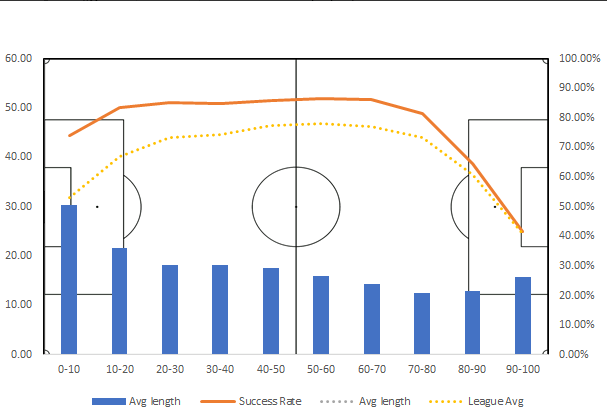
And Birmingham City:

We can also compare every club in the division:

On the left side, James had Grimes, full-back Naughton and attacking midfielder Celina in support.
On the right, full-back Connor Roberts provided wide right attacking support and an option for van Der Hoorn when bringing the ball out from the back.
To compensate for this full-back/winger imbalance, the right winger – usually Nathan Dyer would move inside, usually operating in the right half-space.
Through the middle, Potter usually rotated roles amongst McBurnie, Routledge, and James. Routledge was effective and versatile as a false nine, moving out to the right to link up play when required but also moving back inside to link up play as the attacking collective of players would look to move the ball into the penalty area with quick and effective pass and move play. In addition, the false nine player, usually Routledge and occasionally James would also look for opportunities to run in behind and off the shoulder of the last defender to get into one on one situations.
Oli McBurnie liked to drop deep in either half space to link up the play before moving forward. Rotations between the forward players made it difficult at times for opposition defenders to pick up and mark them closely. As one player dropped in between the lines, this provided the trigger for another to make a forward attacking run.
In midfield, Leroy Fer and later George Byers would often act as a right-sided midfield pivot to help link up play down the right. Van Der Hoorn’s usual target for vertical, line-breaking passes was Connor Roberts or George Byers. Nathan Dyer, operating in the half-space would also drop deep to act as that useful pivot so again, rotations, flexibility, and versatility were key aspects in Potter’s philosophy.
As we can see on the below image, created by taking Potter’s most selected players from his last 10 games in charge, Matt Grimes and Mike van der Hoorn took on the role of deep play makers, with Connor Roberts and Daniel James providing width, and Wayne Routledge and Celina operating in half-spaces. Oliver McBurnie’s link up play is clearly illustrated with his relatively deep positioning on the pitch and the relatively large number of passes he makes (shown by the size of the dot representing him).

Note: We can easily create similar maps for all your opponents, or your recruitment targets.
Out of possession, Swansea were not a high pressing side. They did increase their high pressing intensity for selective matches in the later games in the season but for the most part, they preferred to sit deeper and be well structured and positioned, with high importance placed on ensuring that they blocked off key passing lanes.
Review of current squad options
Goalkeeper
2 goalkeepers shared the number 1 role due to injuries and inconsistent form. Neither goalkeeper could retain the no.1 jersey. Mulder started well but was dropped for Nordfeldt. After poor form, Mulder returned to the first team but again could not retain position. Nordfeldt was re-instated and continued for the rest of the season.
Nordfeldt
Comfortable with the demands of passing out short from the back. Composed with the ball at his feet and could pick the right short pass to suit Swansea’s style of playing out from the defensive third. However, he struggled to command his area, rarely claimed for crosses and contributed to Swansea’s habit of conceding from set pieces. Poor save % too compared to other Championship goalkeepers.
Erwin Mulder
Was solid in his first spell but his limited passing ability – to act as another outfield player likely cost him his place eventually. Better goalkeeping skills than Nordfeldt although he did also start to show vulnerabilities in the air against set pieces.
Steven Benda
Under-23s goalkeeper. No first team experience as yet. Tall and is thought to be comfortable playing the short passing game having required to do so for the under-23s.
Centre-backs
Swansea City mainly used three centre backs during the season in a back 4 with the occasional use of a back 3. Captain Mike van Der Hoorn was ever present, playing in all 46 league games showing good leadership. Joe Rodon started alongside him to begin with before injuries allowed Spurs loanee Cameron Carter-Vickers his first-team chance.
Mike van der Hoorn
Ever present during 2018/19 season, playing in all 46 league games. Tall and dominant centre-back, very comfortable with the ball at his feet and playing progressive vertical passes into the opposition’s half and across the edge of the final third. Lacks pace compared to Rodon. Like Grimes down the left side, the Dutchman helped to progress attacking moves down the right, picking out right-back Connor Roberts or the right-sided midfield pivot – usually George Byers. Not quite as dominant in the air as you might expect given his height having lost a few aerial duels from corners leading to goals conceded.
Joe Rodon
A young and very promising home-grown defender possessing all the attributes of a modern centre-back and has potential to develop into a Premier League player. Standing tall at 6ft 4, strong, has plenty of pace and comfortable with the ball at his feet to suit Swansea’s style. Unlike van der Hoorn who likes to play longer passes to progress the ball forwards, Rodon often preferred to make forward runs into the opposition’s half before finding a team-mate. Injuries ended his season midway through allowing Spurs loanee Carter-Vickers game time.
Cameron Carter-Vickers
Another young player with potential. A very physically-strong player, he doesn’t have the pace of Rodon but he was safe and reliable for the most part in 2018/19. Carter-Vickers played the covering defender role allowing van der Hoorn more freedom to venture forward. Didn’t see a range of passing ability as he usually made the short and simple pass to players like Grimes and van der Hoorn who acted as the deep play-makers from inside their own half.

The above diagram was created from pass data. Passes that are green in colour represent passes made into good attacking areas of the pitch. Red passes are dangerous giveaways close to your own goal. As we can see Cater-Vickers passes are on average deeper and often played into wide areas. Rodon seems to have played more dangerous passes into central areas from higher up the pitch.
Similar diagrams are available for all players we have the data for.
Full-backs
Connor Roberts
Excellent engine & stamina, played 2nd most minutes behind van der Hoorn. Gets up and down the right flank brilliantly. Comfortable with both feet, asked to provide high attacking width down right and also filled in at left-back when required. Often hugged the touchline but earlier in the season he was instructed to move inside, off the wing and operate in the half-space which allowed him to get into better goal-scoring positions. Showed some impressive link-up play down the right to help create goal-scoring opportunities. Defensively solid, good awareness and positioning to make some vital clearances. Aerial success rate is low, particularly inside the penalty area which is one area that needs improvement.
Kyle Naughton
Often played out of position at left-back following Martin Olsson’s season-ending injury. Coped well on his weaker side and grew into the role as the season went on. Became a solid and reliable outlet on the left side and towards the end of the season one of the busiest passes in the team along with Matt Grimes, who played just behind him on the left side of a formed back 3 as the full-backs pushed on. Also one of the busiest tacklers in the team during the season. Graham Potter also moved him into a defensive midfield role occasionally.
Declan John
Took quite some time to settle in after his Summer move. With Olsson and then Naughton in the side he found it difficult to even make the bench at times. Found the defensive side to the game a challenge and looked far more comfortable and productive when given license to play as a winger down the left, especially when playing as a wing-back in the home 1-1 draw against Derby. After the setback away at Sheffield Wednesday when he was subbed at half time, he later recovered after a spell with the under-23s to show his value as a more attacking wing-back. Has decent pace and can deliver a good cross.

As we can see from the above image Connor Robert’s is completing passes more often in the most dangerous areas of the penalty box (the cluster around the penalty spot) than Naughton. However, Naughton is safer with his passing, giving away the ball less in dangerous areas.
Midfielders
Matt Grimes
Picked up a number of awards at the end of season awards dinner at the club – deservedly so. Most passes in the Championship. Was asked to move out of his comfort zone in midfield early and cover at left-back following Olsson’s injury. Made the holding midfield role his own and was excellent, Potter’s philosophy suiting him perfectly. Often slotting back in line with the two centre-backs, Grimes would be at the heart of Swansea’s build-up play from the back – pushing further forward as the build-up progressed through the phases. Whilst he does play a large number of passes short, he can switch play when required with long diagonals to the flanks. Would help keep possession ticking over, showed excellent positional awareness and availability for a pass. He also played a couple of games at centre-back against similar opposition teams who played an attractive style – Brentford and Manchester City. Tenacious in the tackle, likes to take the odd shot at goal and despite a number of shots from outside the box on target, none of them resulted in a goal. A key player for Swansea in 2019/20.

His volume of passing from deep areas, and high level of accuracy gives us a good idea of the skills any future like for like replacement would have to have.
George Byers
Played as a number 10 for the under-23s before adopting a holding midfield role under Graham Potter. Capable in both boxes, excellent passing range in deeper positions, played a right-sided pivot role in a number of games but prefers to offer attacking creativity in the final third. Good ability in dead-ball situations, competing with Matt Grimes for free-kick duty. Capable of finding the net from 20 yards when given the opportunity, excellent versatility in midfield but offers more in the final third.
Jay Fulton
Behind Grimes, Byers and Fer in the pecking order so has had to settle for cameo appearances and coming off the bench when defensive midfield cover is needed to see out leads. Very much a defensive midfielder, offers more when his team are out of possession rather than in it. Very committed and never shy to get involved in physical battles. Not as capable technically compared to Grimes and Byers which holds him back in a possession, passing style of play.
Bersant Celina
Played a pivotal role in Swansea’s attacking play. Capable of playing defence-splitting passes in behind and has great vision to thread passes through to the final third. A number ten but very rarely played as an out and out number 10 in Potter’s team. Was often playing through the left half space, linking up with James down the left wing. Excellent ball-carrying ability and can shoot from range.
Wingers and forwards
Daniel James
A comprehensive review of Daniel James, produced by one of our analysts can be found here: https://totalfootballanalysis.com/player-analysis/player-analysis-dan-james-wales-swansea
Wayne Routledge
Made a huge impact in 2nd half of the season after given green light to play after a contract clause was dropped. Created 12 big chances, the 2nd best in the Championship despite playing fewer games. Very versatile across the front and was regularly played as a false nine central attacker. Has the tendency to be caught offside when running off the shoulder and onto through balls. Very much a one-footed player (right) and will very rarely, if ever, choose to use his left. When playing through the middle, he would often shift over to the right to offer a link-up option for Connor Roberts. Very strong in possession, doesn’t lose the ball easily and that helps him to hold up the ball and bring others into play.
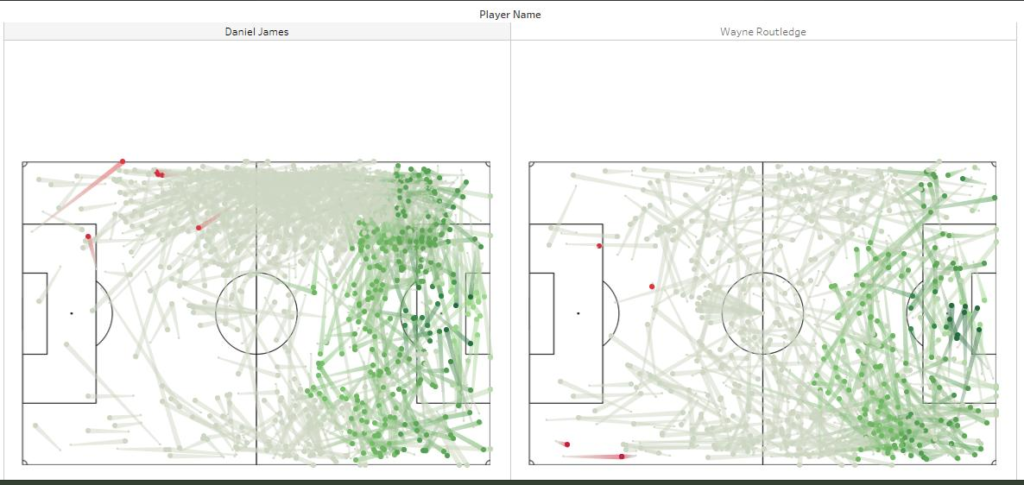
Nathan Dyer
Ten years at Swansea City, not quite made the same impact as Routledge as a fellow winger veteran of the club but added experience along with Wayne after being in the same contract situation and was finally allowed to play regularly. Often played on the right wing but shifting inside through the half space. He would also drop deep to offer a passing option from the defensive line, attracting an opposition midfielder to go with him to create space in behind.
Barrie McKay
Showed some great potential in brief moments but we didn’t see it enough so was never able to compete for a regular starting place. Despite his lack of game time, he contributed with a number of assists and a few goals. Scored a superb winner away at Bolton but compared to Routledge and James, he finds it difficult to hold on to possession and can get dispossessed far too easily. His body language suggests that he lacks interest in games but Potter suggests that’s down to his style than anything else. Needs to be far more consistent to be more involved next season. Potter switched him from the wing and as a central attacking midfielder and looked more useful through the middle.
Joel Asoro
Another new Summer signing that also found it difficult to get game time. Didn’t look ready for Championship football overall but has clear potential. Exceptionally fast and he too switched between winger and central attacking roles as Potter hoped to use his pace in behind the opposition’s line of defence.
Oli McBurnie
Swansea’s top goalscorer with 23 goals. Missed a number of games through illness so an even more impressive return of goals, especially given his tendency to drop deeper into midfield to link-up play, a preference of his according to Potter. With James and more often Routledge playing through the middle, McBurnie would play through the half-space and link up between the wide players and the central attackers. Superb aerial ability and scored a few excellent long range goals using his head. You’d expect plenty of interest in him during the Summer transfer window.
Courtney Baker-Richardson
A backup, bench striker option. Only played a handful of games as he is still very much developing. Season started poorly at Millwall as his poor first touch saw him sent off after a dangerous tackle. He recovered well from that setback though and was given chances off the bench. Despite only making 6 starts, he scored 3 goals – a very decent return in his first senior season. He doesn’t have the hold up ability of McBurnie so was rarely asked to drop back and link up play, very much a number to look for chances inside the penalty area.
Team Comparisons
The contribution of each player to the expected goals of the team can show which players on opposition teams get in good positions to score. We can see that Swansea City had a system where goal attempts were shared around a number of players.
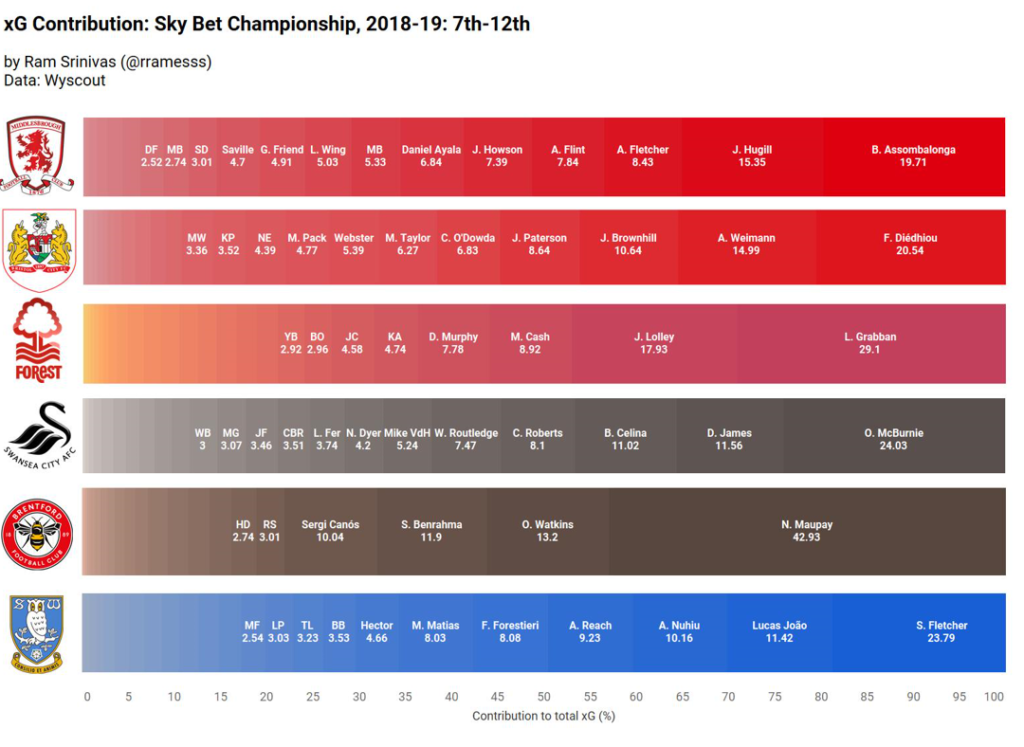
Likewise we can see that chances at Swansea tended to come from the three creative players operating behind the striker without any particular reliance on one individual.

Note: Such diagrams can easily be produced for any league, quickly highlighting player contributions to any area of the pitch.
We can even translate details from a single game into a pass map. This shows the average location of each player on the pitch when they made their passes, the direction of their passes, the completion rate and the number of passes attempted.
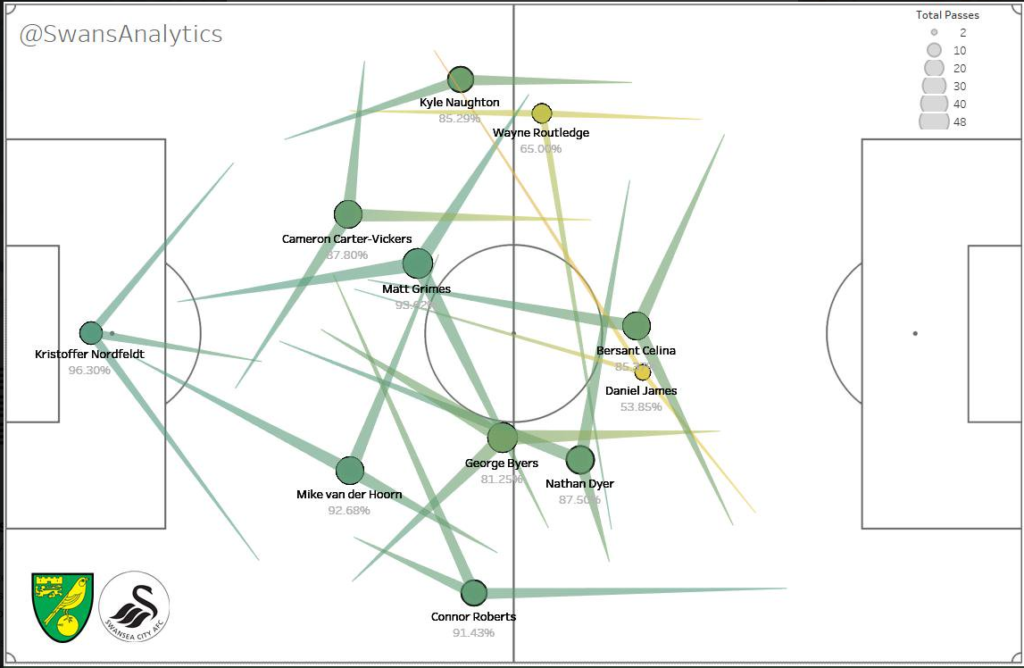
Stage 2 – Define the role
We are able to provide a detailed breakdown and full understanding of a player’s position and the various stylistic roles that are associated within the position. To demonstrate the type of service that can be provided, a case study looking into defenders in the Championship will be presented. The data will aim to cover all aspects of a defender’s role such as defensive performance, passing performance and passing style, all of which will be considered in conjunction with the team’s playing style.
As an initial indicator we will approach the passing data at a high level and look at overall passing stats, this will be done by analysing the distance of passes. This gives us an indication of which players are regularly on the ball, the type of pass that they look to play and how efficiently they are played.


This allows us to understand which defenders play long passes or short passes most frequently and how successfully they do so. This also gives us a glimpse into team style as well as individual player performance. Throughout the process of data analysis it is crucial that results are caveated and contextualised with team data. For example, is it possible to identify a player who plays a lot of successful long passes within a possession based system, are these switches of play which can hurt the opposition or wasteful long balls?
In order to further understand which centre-backs progress the ball best, it is necessary to look at their passing efficiency. This will be measured via forward pass accuracy % and passes to final third accuracy %. This allows us to understand which players pass forward efficiently and which players can do so to more advanced areas of the pitch. Once again we must consider team style and the volume of passes being played into advanced areas of the pitch such as the final third and through balls (a pass played behind the opposition defence). Understanding how often players look to play progressive passes out from the back and those which can do so with efficiency can provide a suitable building block for a progressive passing team. With the added emphasis on ball playing skills from central defenders and desire for players with this profile in Europe’s top leagues this is an area of the market that can provide good return on investment from future sales.


The data can be processed further to a more granular level in which it is possible to understand which players look to play forward with regularity and their accuracy of forward pass. This must be considered in relation to the passing style of the team that the player is deployed in. How does the player in question fair in comparison to their teammates? Is there an emphasis on the player to progress play forwards?
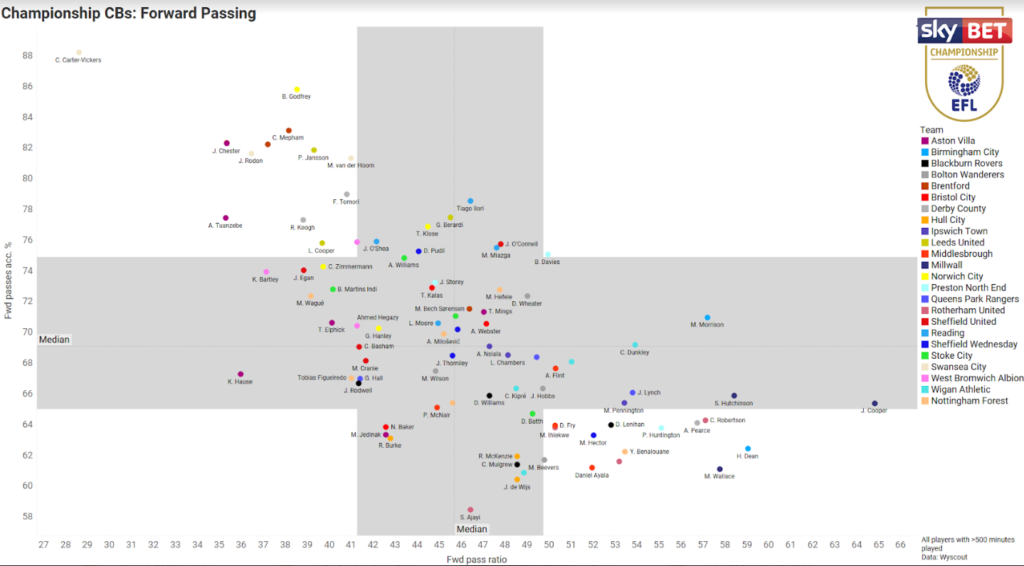
It is also possible to understand how players look to play their forward passes and from which part of the pitch they look to play them from. This can be an indicator as to how adventurous a player’s passing is, however, it should be considered within the team’s passing style. As well as this there is the capacity to understand how a player progresses their passes forward and from which area of the pitch. This can be done by analysing the average start position of passes into the opposition half, coupled with accuracy. From this it is possible to identify players who are capable of dictating play with good accuracy and whether their passes are played from a deep or an advanced position.


The identification process should not neglect the primary responsibility of a defender, to defend. In order to do so, a high level approach will be adopted before delving further into the more granular data metrics. An initial look at aerial duels won % and defensive duels % provides an indication of centre-backs that fit a dominant profile. These metrics do not contain location data and are required to be broken down to a finer level. This can be done by looking at the average position of where aerial duels are won. This allows for the identification of aerially dominant players both outside of the 18-yard box and in the 18-yard box. The latter can be used to identify players suitable for teams with issues defending set pieces and conceding goals from wide areas. It can also determine which players are able to overcome any height differential that may occur when defending aerial duels against an opponent. This can alleviate preconceptions a buying club may have surrounding a players height during the purchase of a defender.




It can be seen that the full dataset provides a comprehensive overview of a defender’s metrics ranging from passing to aerial ability.The process of moving from high level to a more granular metric can be seen, this can be used to understand nuances within an individual’s game that cannot be achieved solely through the eye test. However, it should be noted this is the initial stage of the player identification process and can be built upon further by additional player profiling with the use of player likeness modelling to then be supplemented further with video analysis.
In addition to this in-depth league analysis, a divisional breakdown to these metrics can also be carried out. This provides information on the stylistic tendencies of players within a defensive position, in this example, central defenders. The case study will consider high level metrics from leagues across Europe in order to understand if there may be a league which specialises in producing players with a certain profile that a buying club desires. This can identify untapped markets which may be worth investigating further with the in-depth league analysis detailed above.



Stage 3 – Define the attributes then run the recruitment and scouting process
Our working assumption is that Swansea City will need to consider replacing the following players in the summer transfer window (loans ended, contracts ending, transfer interest):
Cameron Carter-Vickers and Mike van der Hoorn in defence.
Leroy Fer and Matt Grimes in midfield.
Dan James and Oliver McBurnie in the attack.
We have created a stylistic match for each of these players. This involves looking at the area of the game they are involved with; such as the passes they make, their involvement in winning the ball back, or running with the ball; and finding players who are currently performing a similar role.
First we apply this filter to all the data we have on players.
This gives us a list of players who play in a similar style to the player they are replacing.
You may not want this, you may want a player with a different skillset. This does not matter, the system we have created can easily adapt to your specific requirements. We do not rely on a single template if we can get the data we can create custom searches based on your needs.

Comparing the two players shows van der Hoorn profiling much more as a creative passer, playing longer forward passes to start attacks and carrying the ball forward. Carter-Vickers is more heavily involved in aerial activity suggesting he is more likely to attack high balls.

We profiled 10 leagues where we believe it is realistic for Swansea City to attract players from, where transfer fees and wage demands are reasonable, and where the standard of football is sufficiently high for adaption to be possible.
An initial list of players was drawn together from these leagues:

The players were then assessed for age and estimated transfer value.
A short list was then created.

The shortlist was further reduced by initial video scouting and further research into the player’s likely availability.
Example Data output:

As an example of the type of results the stylistic match produces we can see Phillipe Sandler is recommended as a potential replacement for van der Hoorn based on his ability to progress the ball forwards whilst playing in the Netherlands. Whilst Felix Eboa Eboa is recommended as a Carter-Vickers replacement based on his superior defensive statistics and his likely availability.

Lesser known players were also suggested and manually scouted
Denys Bain, 25 – Le Havre
Technical (Footedness / passing range / press resistance / 1v1 defending)
Ability to play as left or right sided centre-half
Ability to play long passes with both feet, frequently hits diagonal to player positioned high and wide to switch play – predominantly left to right. Looks to be a recognition of opportunity to get wide player on the ball 1v1 when not in possession of ball and not under pressure.
Tackles predominantly with left foot, looks to get tight to attacker when back to goal.
Physical (Aerial duels, speed, agility)
Possesses good pace, this allows him to be dominant with balls played into the channels.
Pace can cover up momentary lapses of concentration and poor body shape which results in recovery tackles being required.
Lapses of concentration also result in poor body shape which results in an extra couple of paces when turning.
Aerially dominant, in particular from straight balls from goalkeeper where he looks to head into midfield to allow for second ball to be collected by midfielders.
Assessment (Is he worth further scouting?)
Reservations over momentary lapses of confidence, pace appears to get him out of a number of sticky situations. Would not recommend.
Alexander Djiku, 24 – SM Caen
Technical (Footedness / passing range / press resistance / 1v1 defending)
Ability to tackle using both feet, reduces need to tackle across body and reduces likelihood of concession of fouls.
Recognises danger developing early in channels.
Right footed player capable of playing as left sided centre-half.
When ball is wide opens up body position early to recognise runners.
Comfortable receiving the ball with either foot and calm under pressure.
Ability to hit long diagonal pass, flat trajectory allows for pace of attack to be maintained.
Physical (Aerial duels, speed, agility)
Powerful defender with good pace and ability to rotate through hips quickly to react to changes in angle.
Powerful and comfortable when getting into physical contact with opposition striker when ball on ground.
Due to height 182cm can be pinned by centre-forward on longer straight passes.
Assessment (Is he worth further scouting?)
Yes, address concerns over aerial duels from long balls.
Niakate, 19 – Valenciennes
Technical (Footedness / passing range / press resistance / 1v1 defending)
Can play as both a left sided centre-half and left-back, as a result is comfortable defending 1v1 in channel.
Ability to travel wide with ball down left flank and deliver crosses.
Long passing is often straight and lower percentage ball aimed to target man’s head.
Looks to slow attacker down when in 1v1 defensive situations.
Physical (Aerial duels, speed, agility)
Could be a possible option for a left sided defender in back three.
183cm with rangy running style.
19 years old with potential that his frame will fill out.
Assessment
One to keep an eye on, perhaps not ready to become a first team member at this moment in time.
Denis Kolinger, 25 – Lokomotiva Zagreb
Technical
Right footed player with decent short passing range, looks to play forward into midfield where possible.
Long range passing is often a more floated ball, allows for opposition defence to readjust and tempo of attack lost.
Pace of league naturally slower, looks comfortable on ball however this may change in a higher tempo league.
Physical
199cm tall and very capable in the air from long balls and crosses into box. Also carries potential to add offensive threat from set pieces.
Not as pacy as others, a rangy runner. As a result looks to go to ground early when dragged into channel.
Assessment
Issues with defending corners may require someone of aerially dominant profile to help deal with this issue. Concerns over how he would be able to get up to speed with league and quality on the ball.
Wahl, 25 – Kiel
Technical
Comfortable stepping out from the back into midfield and breaking first line of opposition press via dribble. Notable that this done with tempo and sets a good tone for the team.
Very comfortable on the ball and looks to play forward between the lines.
Comfortable with the ball at his feet higher up the pitch and playing into the final third.
Physical
Aerially not the most dominant, appears to struggle to get off the ground. Loss of headers in own half from straight balls a regular occurance.
Average athlete, lack of pace does not appear that it will cause issues.
Assessment
On the ball qualities alone make him worthwhile exploring further. Ability to beat first line of press and step into midfield a particular highlight.
Souttar
Technical
Right footed with good long passing range, looks to punch passes over a long distance.
Looks to play creatively into final third into areas that will hurt the opposition, particularly in behind opposition defence.
Comfortable stepping out from the back into midfield to beat first line of opposition press.
Physical
Lacks the agility of some more athletic players.
Assessment
Looks comfortable on the ball, defensive to be reviewed with further video
The exercise was repeated for Grimes:
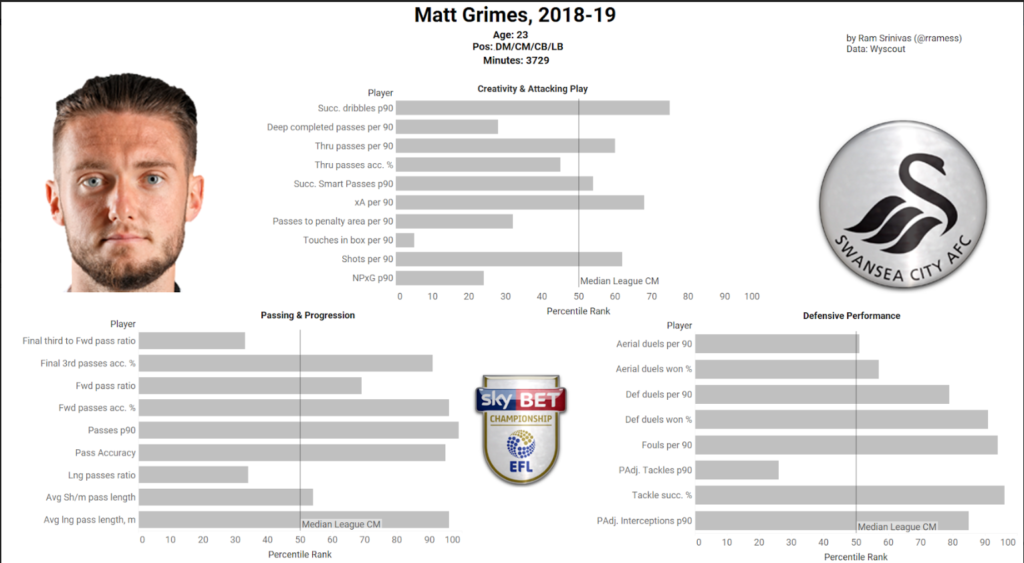
Suggested stylistic matches:

Example player:

Maxime D’Arpino came through the youth system at Olympic Lyonnaise. He could not displace their central midfield options and joined Orleans in the summer. In the second half of the season he established himself as a competitive, creative player on a relatively small team in a physically strong league. He is particularly good at progressing the ball forward from deep midfield.
Leroy Fer replacement

Fer offers defensive solidity combined with ball carrying.
Another template was constructed to match these outputs, whilst also looking for better passing output.
Again 10 leagues were searched and a short list was produced.

Two players stood out as being particularly capable, and likely to be available.

Joe Williams has completed two seasons on loan in the Championship at relegation-threatened teams but has put in excellent performances. He only has 1 year left on his Everton contract.
Martins Pereira has completed two loans in Ligue 2 from Lyon. He too only has 1 year left on his contract and offers more attacking threat than Williams.

Dan James

Dan James is hard to replace. His biggest asset, pace, cannot be measured on a template. The best we can do is try and match his attacking output and then scout for players also offering pace to run in behind defences.
The shortlist for scouting

Of the selected players Zinedine Ferhat is an interesting option, available on a free transfer. He is not a like for like replacement for Dan James, but his range of creative passing could provide a different option.
Oliver McBurnie

McBurnie’s all-around profile is excellent showing a versatile striker capable of contributing in build-up play. Like Dan James, this type of output is hard to match.

Intriguing options are Jordan Tell, a young French striker on the fringes at Rennes and Tomane, a Portuguese striker with excellent creativity and finishing ability.
Additional projects
Examples of other projects undertaken:
Pass Score:
A model to score passes in terms of their contribution to creating goalscoring chances.
A selection of tactical writing on Swansea City
https://totalfootballanalysis.com/author/kevin-elphick
Full back analysis
https://medium.com/ram-blings/profiling-championship-full-backs-3bb3cb511737
Centre back analysis and writing on Spanish football
https://wakelet.com/@PannasNutmegs
Writing for Statsbomb on data analytics
Project to use historical data to identify metrics which predict future star players
https://stopbunching.blogspot.com/2019/05/scouting-by-time-machine-france.html
We can help you decide how best to use the data you hold to make sensible decisions.
Contact: contact@mrktinsights.com

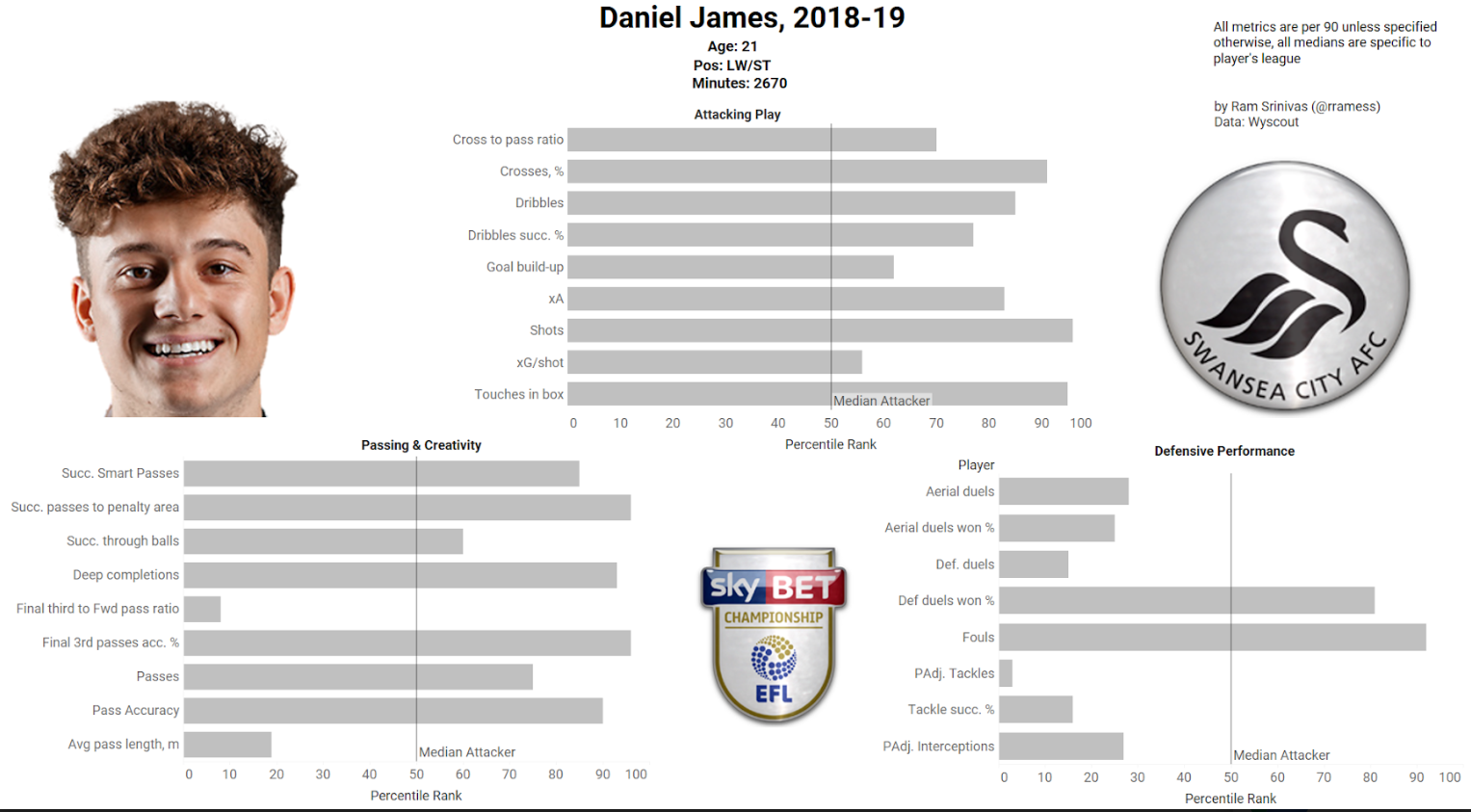
Leave a comment